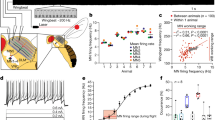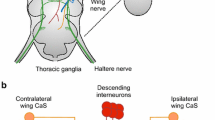Abstract
Real pattern-generating networks often consist of more neurons than necessary for the production of a certain rhythm. We investigated the question of whether these neurons contribute to the robustness of a pattern-generating system of using the central pattern generator (CPG) for flight of the locust, generating the deafferented activity pattern of wing elevator and wing depressor motoneurons, as an example of a rhythm-generating system. The neuronal network was reconstructed, based on the known connectivity of the interneurons in the flight CPG, using a biologically orientated network simulator (BioSim 3.0). This simulator allows a physiologically realistic simulation of particular neurons as well as the synaptic connections between them. The flight CPG consists of at least five cyclic loops. The simulation shows that each of them is in principle able to produce a rhythm comparable to the rhythm produced by the whole network, i.e. the ‘deafferented’ flight pattern of elevator and depressor motoneurons. Varying the parameter ‘synaptic strength’ in each of these loops and in the complete system shows that this parameter can be changed within certain ranges without loosing the ability to produce oscillations. These ranges are much smaller in each of the subloops than in the whole network. This result demonstrates that the robustness of the system is increased by supranumerary neurons and connections. Changing the active properties of the simulated neurons so that they are able to produce plateau potentials has no effect on the robustness of the simulated network.
Similar content being viewed by others
References
Bässler (1986) On the definition of central pattern generator and its sensory control. Biol Cybern 54:65–69
Cruse H (1981) Biologische Kybernetik. Verlag Chemie, Weinheim
Friesen WO, Stent GS (1977) Generation of a locomotary rhythm by a neural network with recurrent cyclic inhibition. Biol Cybern 28:27–40
Kien J, Heichele R (1993) How is the flight rhythm generated? Attractor neural networks and motor pattern generation. In: Wiese K, Gribakin FG, Popov AV, Renninger G (eds) Sensory systems of arthropods. Birkhäuser Verlag, Basel, pp 578–589
Koch U, Brunner M (1988) A modular analog neuron-model for research and teaching. Biol Cybern 50:303–312
Rall W (1989) Cable theory for dendritic neurons. In: Koch C, Segev I (eds) Methods in neuronal modeling: from synapses to network. MIT Press, Cambridge, Mass.
Ramirez JM, Pearson KG (1991a) Octopamine induces burstingand plateau potentials in insect neurons. Brain Res 549:332–337
Ramirez JM, Pearson KG (1991b) Octopaminergic modulation of interneurons in the flight system of the locust. J Neurophysiol 66:1522–1537
Ramirez JM, Pearson KG (1993) Alteration of bursting properties in interneurons during locust flight. J Neurophysiol 70:2148–2160
Robertson RM (1985) Central neuronal interactions in the flight system of the locust. In: Gewecke M, Wendler G (eds) Insert locomotion. Paul Parey Verlag, Ham burg, Berlin, pp 183–194
Robertson RM (1987) Neuronal circuits controlling flight in the locust: central generation of the rhythm. Trends Neurosci 9:278–280
Robertson RM (1991) Delayed excitatory connection in the flight system of the locust. J Neurophysiol 65:1150–1157
Robertson RM, Pearson KG (1983) Interneurons in the flight system of the locust: distribution, connections and resetting properties. J Comp Neurol 215:33–50
Robertson RM, Pearson KG (1984) Interneurons organization in the flight system of the locust. J Insect Physiol 30:95–101
Robertson RM, Pearson KG (1985) Neural circuits in the flight system of the locust. J Neurophysiol 53:110–128
Robertson RM, Reye DN (1988) A local circuit in the flight system of the locust. J Neurosci 8:3929–3936
Rowat FP, Selverston AI (1993) Modeling the gastric mill central pattern generator of the lobster with a relaxation-oscillator network. J Neurophysiol 70:1030–1053
Selverston AI, Moulins M (1987) The stomatogastric system. Springer, Berlin Heidelberg New York
Wilson DM, Waldron J (1968) Models for the generation of the motor output pattern in flying locust. Proc IEEE 56:1058–1064
Wolf H (1991) Sensory feedback in the locust flight pattering. In: Amstrong DM, Bush BMH (eds) Local neural mechanism in arthropods and vertebrates. Manchester University Press, Manchester, pp 134–148
Wolf H, Pearson KG (1988) Proprioceptive input patterns elevator activity in the locust flight system. J Comp Physiol 161:115–129
Author information
Authors and Affiliations
Rights and permissions
About this article
Cite this article
Grimm, K., Sauer, A.E. The high number of neurons contributes to the robustness of the locust flight-CPG against parameter variation. Biol. Cybern. 72, 329–335 (1995). https://doi.org/10.1007/BF00202788
Received:
Accepted:
Published:
Issue Date:
DOI: https://doi.org/10.1007/BF00202788




